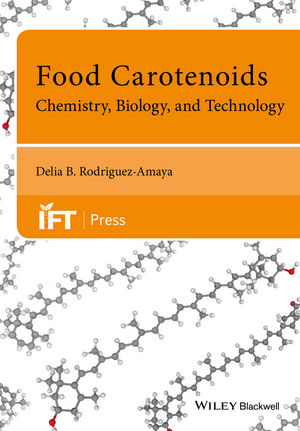
Food Carotenoids
Wiley-Blackwell (Verlag)
978-1-118-73330-1 (ISBN)
Food Carotenoids: Chemistry, Biology and Technology gathers all the important information about these major compounds which impact both food quality and human health. It integrates in one volume various aspects of food carotenoids, such as:
Structures and physicochemical properties
Biosynthetic pathways and metabolism
Analysis and composition of foods
Stability and reactions during processing
Commercial production as food colorants and precursors of aroma compounds
Bioavailability and health benefits
Having worked with carotenoids in various aspects for 44 years, Delia Rodriguez-Amaya is uniquely placed to pass on her wealth of knowledge in this field. This book will serve as solid background information for professionals in Food Science, Food Technology, Nutrition, Agriculture, Biology, Chemistry and Medical Sciences, whether in the academe, industry, governmental and non-governmental agencies.
Professor Delia B. Rodriguez-Amaya is President of the International Academy of Food Science and Technology. She holds a Ph.D. in agricultural chemistry from the University of California–Davis, USA, and is the author of more than 240 scientific publications. Her three monographs (A Guide to Carotenoid Analysis in Foods; HarvestPlus Handbook for Carotenoid Analysis; and Carotenoids and Food Preparation: _ e Retention of Provitamin A Carotenoids in Prepared, Processed and Stored Foods) are widely read and cited as basic references in a total of more than 1,400 (as of April 2015) research and review papers.
Preface xiii
1 Nomenclature, structures, and physical and chemical properties 1
1.1 Introduction 1
1.2 Nomenclature 1
1.3 Nature of carotenoids in foods 3
1.3.1 Carotenes 5
1.3.2 Xanthophylls 5
1.3.3 Z-isomers 11
1.3.4 Apocarotenoids 12
1.4 Physicochemical properties 13
1.4.1 Size and shape 13
1.4.2 Solubility 13
1.4.3 Light absorption and color 13
1.5 Antioxidant properties 14
1.5.1 Quenching of singlet oxygen 14
1.5.2 Free radical scavenging 15
1.5.3 Relative efficacy of individual carotenoids 17
1.6 Prooxidant effect 18
1.7 Interaction with other antioxidants 19
References 20
2 Biosynthesis and metabolism 24
2.1 Introduction 24
2.2 Biosynthesis in plants 24
2.2.1 Formation of isopentenyl diphosphate 27
2.2.2 Chain elongation to GGPP and formation of phytoene 29
2.2.3 Desaturations from phytoene to lycopene 29
2.2.4 Cyclization to β-carotene and α-carotene 30
2.2.5 Formation of xanthophylls 31
2.3 Cleavage to apocarotenoids 32
2.4 Regulation of carotenoid biosynthesis 34
2.5 Carotenogenesis and fruit ripening 35
2.6 Carotenogenesis and seed and root development 38
2.7 Functions in plants 38
2.8 Metabolism in animals 41
References 41
3 Qualitative and quantitative analyses 47
3.1 Introduction 47
3.2 Structure elucidation and qualitative analysis 47
3.3 Quantitative analysis 49
3.3.1 Storage of samples 49
3.3.2 Total carotenoid content 50
3.3.3 Quantification of individual carotenoids 51
3.3.3.1 Sampling 51
3.3.3.2 Preparation of the analytical sample 53
3.3.3.3 Extraction 54
3.3.3.4 Partition 56
3.3.3.5 Saponification 57
3.3.3.6 Concentration or evaporation of the solvent 57
3.3.3.7 Chromatographic separation 58
3.3.3.8 Identification 59
3.3.3.8.1 UV-visible absorption spectrometry 61
3.3.3.8.2 Mass spectrometry 65
3.3.3.8.3 Reactions of functional groups 65
3.3.3.9 Quantitation 66
3.3.4 Sources of errors and precautionary measures 67
3.3.5 Method validation and quality assurance 70
3.3.6 UHPLC-DAD methods 72
3.3.7 Other methods 73
3.4 Calculation of retention in cooked and processed food 75
References 76
4 In vitro assays of bioaccessibility and antioxidant capacity 82
4.1 Introduction 82
4.2 In vitro assessment of bioaccessibility 82
4.2.1 Static gastrointestinal digestion assays 83
4.2.2 Dynamic gastrointestinal models 86
4.3 In vitro assessment of antioxidant activity 86
References 90
5 Composition and influencing factors 96
5.1 Introduction 96
5.2 Composition of leafy and nonleafy green vegetables 97
5.3 Composition of fruits and fruit vegetables 97
5.4 Composition of roots, seeds, and flowers 104
5.5 Composition of processed foods 104
5.6 Rich sources of the major food carotenoids 106
5.7 Genetic and environmental factors affecting carotenoid composition 109
5.7.1 Cultivar/variety 109
5.7.2 Stage of maturity 113
5.7.3 Climate, season, geographic site, and year of production 116
5.7.4 Farming practice and conditions 118
5.8 Carotenoid distribution in a fruit or vegetable 119
5.9 Metabolic engineering of carotenoid biosynthesis 120
5.10 Carotenoids of animal-derived foods 122
References 123
6 Effects of processing and storage 132
6.1 Introduction 132
6.2 Postharvest storage 133
6.3 Effects of home preparation 135
6.4 Effects of thermal processing 138
6.4.1 Preliminary operations 139
6.4.2 Thermal treatment 139
6.4.3 Drying 143
6.5 Effects of sun and solar drying 145
6.6 Effects of nonthermal processing 147
6.6.1 Minimal processing 147
6.6.2 High-pressure processing 149
6.6.3 High-intensity pulsed electric field processing 152
6.6.4 Irradiation 153
6.7 Storage of processed foods 153
6.8 Microencapsulation and nanoencapsulation 156
6.8.1 Microcapsules 156
6.8.2 Nanocapsules and nanodispersions 160
6.9 Utilization of industrial by-products 162
References 163
7 Isomerization and oxidation 174
7.1 Introduction 174
7.2 Overall degradation scheme 175
7.3 Kinetics 176
7.4 Isomerization 177
7.5 Oxidation 179
7.5.1 Epoxidation 179
7.5.2 Cleavage to apocarotenals 183
7.5.3 Formation of low-mass compounds 186
7.5.4 Influencing factors 190
7.6 Implications on food quality 191
7.7 Implications for human health 192
References 194
8 Carotenoids as food colorants and precursors of aroma compounds 199
8.1 Introduction 199
8.2 Carotenoids as food colorants 199
8.2.1 Natural carotenoid colors 200
8.2.2 Nature-identical synthetic carotenoids 202
8.2.3 Carotenoids produced by biotechnology 204
8.2.4 Potential production from other microorganisms 205
8.3 Carotenoids as precursors of aroma compounds 207
8.3.1 Enzymatic generation of aroma compounds from carotenoids 207
8.3.1.1 Characterization of the enzymes 207
8.3.1.2 Carotenoid-derived aroma compounds of fruits and vegetables 211
8.3.1.3 Carotenoid-derived aroma compounds of saffron 212
8.3.2 Nonenzymatic generation of aroma compounds from carotenoids 214
8.3.4 Carotenoid-derived aroma compounds of tea and wine 217
References 218
9 Bioaccessibility and bioavailability 225
9.1 Introduction 225
9.2 Absorption, metabolism, and transport 225
9.3 Methods for determining bioavailability 228
9.4 Dietary factors affecting bioavailability 229
9.4.1 Nature of the food matrix 230
9.4.2 Carotenoid species 233
9.4.3 Geometric configuration 235
9.4.4 Carotenoid-carotenoid interaction 237
9.4.5 Amount and type of fat 238
9.4.6 Amount and type of dietary fiber 240
9.4.7 Other food constituents 241
9.4.8 Processing 242
9.4.8.1 Home cooking 242
9.4.8.2 Industrial processing 244
References 246
10 Provitamin A activity 255
10.1 Introduction 255
10.2 Bioconversion of provitamin A carotenoids 256
10.3 Bioefficacy and vitamin A equivalency of provitamin A carotenoids 258
10.4 Strategies to combat vitamin A deficiency 260
10.4.1 Vitamin A supplementation 261
10.4.2 Food fortification 262
10.4.3 Dietary diversification 263
10.4.3.1 Home gardening 264
10.4.3.2 Breast-feeding 265
10.4.3.3 Reduction of postharvest losses 265
10.4.4 Conservation of biodiversity for food and nutrition 266
10.4.5 Biofortification 267
10.5 Potential provitamin A sources for alleviating vad 269
10.5.1 Red palm oil 269
10.5.2 Green leafy vegetables 270
10.5.3 Carrot and orange-fleshed sweet potato 271
10.5.4 Tropical fruits 272
10.6 Current status of β-carotene research 272
References 274
11 Carotenoids and chronic diseases 282
11.1 Introduction 282
11.2 Evidence of health benefits/efficacy 282
11.3 Mode of action 285
11.4 Protection against cancer 286
11.5 Protection against cardiovascular disease 290
11.6 Protection against cataract and macular degeneration 292
11.7 Protection of cognitive functions 293
11.8 Other health benefits 294
11.9 Concluding remarks 296
References 296
Index 305
| Reihe/Serie | Institute of Food Technologists Series |
|---|---|
| Verlagsort | Hoboken |
| Sprache | englisch |
| Maße | 170 x 244 mm |
| Gewicht | 771 g |
| Themenwelt | Sachbuch/Ratgeber ► Gesundheit / Leben / Psychologie ► Ernährung / Diät / Fasten |
| Medizin / Pharmazie | |
| Naturwissenschaften ► Biologie | |
| Technik ► Lebensmitteltechnologie | |
| Weitere Fachgebiete ► Land- / Forstwirtschaft / Fischerei | |
| ISBN-10 | 1-118-73330-4 / 1118733304 |
| ISBN-13 | 978-1-118-73330-1 / 9781118733301 |
| Zustand | Neuware |
| Haben Sie eine Frage zum Produkt? |
aus dem Bereich


